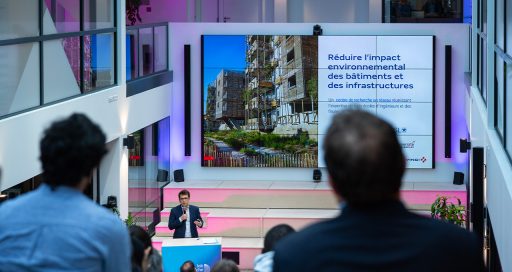EDF opts for indoor modular substations with support from Omexom
Reading time: 5 min
French utility EDF has adopted indoor modular substations, a system that offers many advantages, especially environmental ones, compared with the other two types of substation. EDF is being supported in the rollout of this nationwide programme by three partners including Omexom, the expert VINCI Energies brand.
Indoor modular substation blends into the environment of the Basque Country – Registered architect Benoît MARTRES
A high voltage and extra high voltage electricity transmission network requires a whole range of infrastructure, including cables, towers and transformers, which don’t always blend easily into their environment. Over the last few decades, however, progress has been made in substations.
The purpose of this network component is to step up voltage for transmission, then to step it back down for use by end-consumers.
There are three types of substation. The most widespread type, particularly in rural areas, is the outdoor above-ground substation. It presents a number of disadvantages, not least the clearance required between the various components to ensure insulation. This increases its footprint.
“An outdoor substation requires ongoing maintenance due to premature ageing of the equipment,” explains Philippe Lucienne, sales manager for the energy transmission/transformation division and the indoor modular substation programme for Omexom. “Furthermore, the equipment poses increased security and intrusion risks since the live components are more easily accessible and cable theft is a real possibility.”
The second type of substation, located inside buildings in large cities, is designed to be compact so as to reduce the footprint. In order to insulate electrical conduits, it uses a compressed gas, sulphur hexafluoride (SF6), which is known for its negative environmental impact. Another drawback of this kind of equipment is that, in most cases, maintenance is the responsibility of the manufacturer.
A modular, cleaner solution
Indoor modular substations are less compact than substations in buildings but only take up 20% of the surface area of an above-ground substation. Plus, they blend into their environment more effectively. They also use considerably less SF6 and offer increased security, since a partitioning and locking system make any contact between an engineer and live parts impossible.
More compact, indoor modular substations are better at blending into their environment and use less sulphur hexafluoride
“This equipment is referred to as modular because it combines various components, like Lego, producing different configurations as required,” states Philippe Lucienne. “One module comprises the control room, and another the batteries.” A further advantage of this modular system is that the substation can be extended without disconnecting the existing switches.
Based on these solid reasons, EDF initiated an indoor modular substation policy two years ago. Three partners were selected under a national, twice-renewable, 4-year contract, which got under way in the spring of 2020 and which covers mainland France and the French overseas departments. Omexom is one of the three partners.
This VINCI Energies brand, which specialises in electricity generation, transmission, transformation and distribution projects, received approval for the product to be put into use on the network after a series of laboratory tests and trials.
Omexom is also providing services to two EDF subsidiaries, RTE and Enedis, semi-private electro-intensive companies that have the same high voltage power supply requirements as industrial groups or data centre operators.
Each project is specific
Each project in the EDF contract is specific, depending on the location of the modular structure – in a city or on a plot of land. “Omexom works with architecture firms on the design of the building and its surroundings,” says Philippe Lucienne. “The project team also brings civil works services and local firms on board, outsourcing technical packages like air conditioning to them.”
So far, Omexom has completed two projects, one in Orléans, and the other in Guadeloupe for EDF’s island energy systems department. Its teams are currently carrying out two other projects, one in the Alps with RTE and local distribution operator Sorea, and the other in the Basque Country with Enedis. The year 2022 began with the award of a major project for the city of Metz’s distribution operator. Further projects are expected.
18/03/2022





